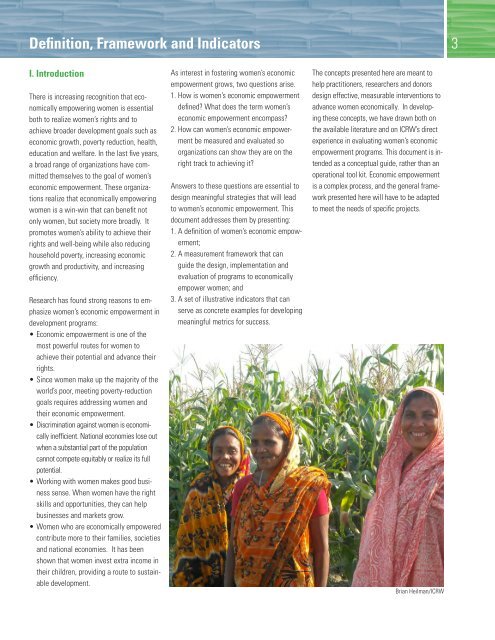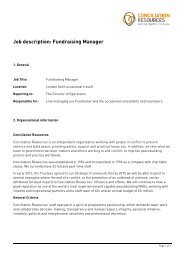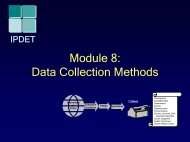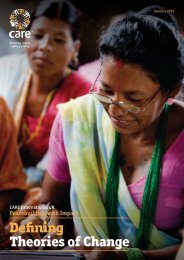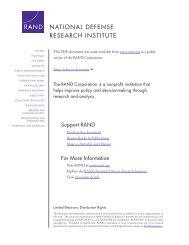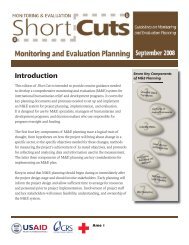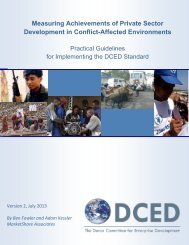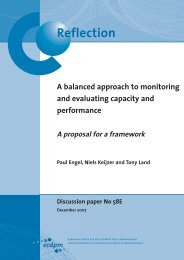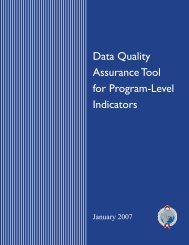Understanding and measuring womens economic ... - ICRW
Understanding and measuring womens economic ... - ICRW
Understanding and measuring womens economic ... - ICRW
Create successful ePaper yourself
Turn your PDF publications into a flip-book with our unique Google optimized e-Paper software.
Definition, Framework <strong>and</strong> Indicators 3I. IntroductionThere is increasing recognition that <strong>economic</strong>allyempowering women is essentialboth to realize women’s rights <strong>and</strong> toachieve broader development goals such as<strong>economic</strong> growth, poverty reduction, health,education <strong>and</strong> welfare. In the last five years,a broad range of organizations have committedthemselves to the goal of women’s<strong>economic</strong> empowerment. These organizationsrealize that <strong>economic</strong>ally empoweringwomen is a win-win that can benefit notonly women, but society more broadly. Itpromotes women’s ability to achieve theirrights <strong>and</strong> well-being while also reducinghousehold poverty, increasing <strong>economic</strong>growth <strong>and</strong> productivity, <strong>and</strong> increasingefficiency.Research has found strong reasons to emphasizewomen’s <strong>economic</strong> empowerment indevelopment programs:• Economic empowerment is one of themost powerful routes for women toachieve their potential <strong>and</strong> advance theirrights.• Since women make up the majority of theworld’s poor, meeting poverty-reductiongoals requires addressing women <strong>and</strong>their <strong>economic</strong> empowerment.• Discrimination against women is <strong>economic</strong>allyinefficient. National economies lose outwhen a substantial part of the populationcannot compete equitably or realize its fullpotential.• Working with women makes good businesssense. When women have the rightskills <strong>and</strong> opportunities, they can helpbusinesses <strong>and</strong> markets grow.• Women who are <strong>economic</strong>ally empoweredcontribute more to their families, societies<strong>and</strong> national economies. It has beenshown that women invest extra income intheir children, providing a route to sustainabledevelopment.As interest in fostering women’s <strong>economic</strong>empowerment grows, two questions arise.1. How is women’s <strong>economic</strong> empowermentdefined? What does the term women’s<strong>economic</strong> empowerment encompass?2. How can women’s <strong>economic</strong> empowermentbe measured <strong>and</strong> evaluated soorganizations can show they are on theright track to achieving it?Answers to these questions are essential todesign meaningful strategies that will leadto women’s <strong>economic</strong> empowerment. Thisdocument addresses them by presenting:1. A definition of women’s <strong>economic</strong> empowerment;2. A measurement framework that canguide the design, implementation <strong>and</strong>evaluation of programs to <strong>economic</strong>allyempower women; <strong>and</strong>3. A set of illustrative indicators that canserve as concrete examples for developingmeaningful metrics for success.The concepts presented here are meant tohelp practitioners, researchers <strong>and</strong> donorsdesign effective, measurable interventions toadvance women <strong>economic</strong>ally. In developingthese concepts, we have drawn both onthe available literature <strong>and</strong> on <strong>ICRW</strong>’s directexperience in evaluating women’s <strong>economic</strong>empowerment programs. This document is intendedas a conceptual guide, rather than anoperational tool kit. Economic empowermentis a complex process, <strong>and</strong> the general frameworkpresented here will have to be adaptedto meet the needs of specific projects.Brian Heilman/<strong>ICRW</strong>


